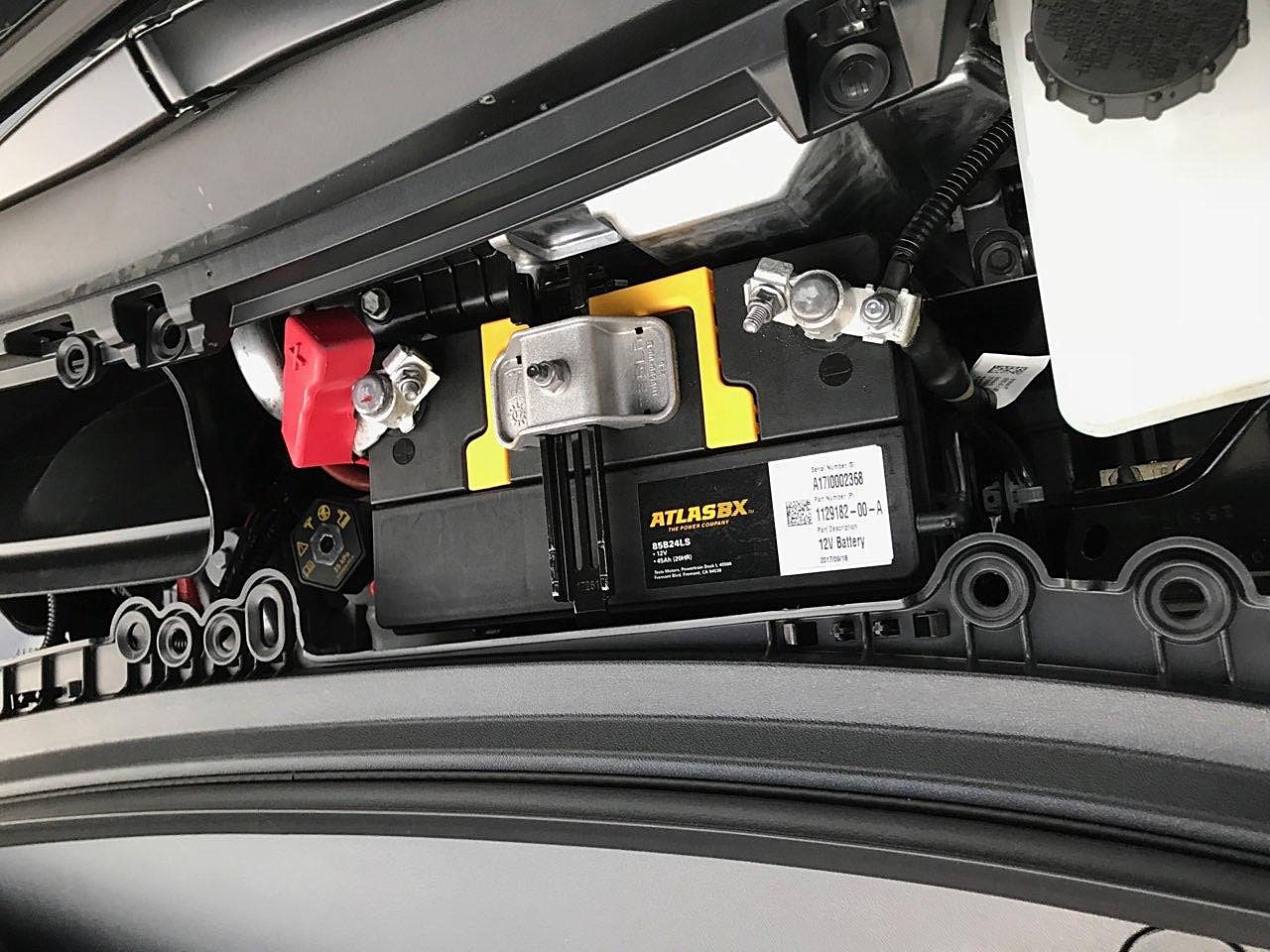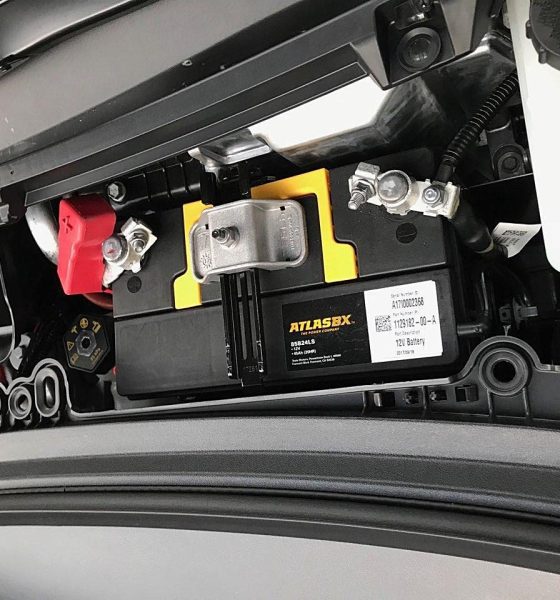

News
Tesla’s 12V batteries set to receive major improvements through software update
The Tesla ownership experience is intended to be as convenient as possible, with the vehicles themselves needing very little maintenance and practices like charging being effortless with the Supercharger Network’s plug-and-play nature. Yet even amidst all these conveniences, Tesla owners have cited a notable pain point in their ownership experience: their cars’ 12V battery.
RELATED: Tesla 12V Lithium-Ion battery replacement (up to 70% lighter, 4x life)
Similar to traditional vehicles, Teslas utilize a conventional 12V battery to power components like emergency blinkers, airbags, seatbelt pre-tensioners, and the infotainment system. Typical 12V batteries last about 3-4 years under normal use in a fossil fuel-powered vehicle, but among Tesla owners, especially those who drive frequently, the lifespan of 12V batteries have been reported to go down to as short as 1-2 years.
Adding to the inconvenience is the fact that Teslas currently do not have a feature that notifies owners about the health of their cars’ 12V batteries. Tesla owners have responded to this by requesting for an update that would allow them to view the current state of their vehicles’ 12V batteries. One such request was posted on Twitter recently, with Tesla enthusiast @TeslaVibes stating that such a feature needs to be implemented in a future update.
Interestingly enough, Elon Musk completely agreed with the Tesla enthusiast’s request. The Tesla CEO added that major software improvements are set to be released for vehicles’ 12V batteries, which should allow them to last longer. “Couldn’t agree more — major software improvements are already in place to extend its life & more coming,” Musk wrote.
Considering Musk’s post, it seems that an update that would include 12V battery health warnings is all but confirmed. Such a feature will likely be universally appreciated by Tesla owners, as it could address a particularly infuriating part of the electric car ownership experience. Such a feature, if any, would definitely reduce the instances of owners running into major inconveniences when their vehicles’ 12V battery dies.
Elon Musk’s Twitter post suggests that Tesla is well aware of the limitations that 12V batteries still bring to the EV ownership experience. With this in mind, it would not be surprising if the company comes up with a superior alternative for 12V batteries in the coming years. Tesla, after all, is known for its quick pace of innovation, and the 12V battery is certainly an area that is in great need of some innovation.
It should be noted that the earliest versions of the original Tesla Roadster did not use a traditional 12V battery. Instead, Tesla opted to utilize a portion of the vehicle’s main lithium-ion battery pack to supply 12V for the all-electric sports car’s accessories and lights. The system was quite novel, but the idea was later dropped in favor of a more traditional 12V battery. Conventional 12V batteries were initially used for the original Roadster 2.0, and in every vehicle that Tesla has released since.

News
Tesla China quietly posts Robotaxi-related job listing
Tesla China is currently seeking a Low Voltage Electrical Engineer to work on circuit board design for the company’s autonomous vehicles.

Tesla has posted a new job listing in Shanghai explicitly tied to its Robotaxi program, fueling speculation that the company is preparing to launch its dedicated autonomous ride-hailing service in China.
As noted in the listing, Tesla China is currently seeking a Low Voltage Electrical Engineer to work on circuit board design for the company’s autonomous vehicles.
Robotaxi-specific role
The listing, which was shared on social media platform X by industry watcher @tslaming, suggested that Tesla China is looking to fill the role urgently. The job listing itself specifically mentions that the person hired for the role will be working on the Low Voltage Hardware team, which would design the circuit boards that would serve as the nervous system of the Robotaxi.
Key tasks for the role, as indicated in the job listing, include collaboration with PCB layout, firmware, mechanical, program management, and validation teams, among other responsibilities. The role is based in Shanghai.
China Robotaxi launch
China represents a massive potential market for robotaxis, with its dense urban centers and supportive policies in select cities. Tesla has limited permission to roll out FSD in the country, though despite this, its vehicles have been hailed as among the best in the market when it comes to autonomous features. So far, at least, it appears that China supports Tesla’s FSD and Robotaxi rollout.
This was hinted at in November, when Tesla brought the Cybercab to the 8th China International Import Expo (CIIE) in Shanghai, marking the first time that the autonomous two-seater was brought to the Asia-Pacific region. The vehicle, despite not having a release date in China, received a significant amount of interest among the event’s attendees.
Elon Musk
Elon Musk and Tesla AI Director share insights after empty driver seat Robotaxi rides
The executives’ unoccupied tests hint at the rapid progress of Tesla’s unsupervised Robotaxi efforts.

Tesla CEO Elon Musk and AI Director Ashok Elluswamy celebrated Christmas Eve by sharing personal experiences with Robotaxi vehicles that had no safety monitor or occupant in the driver’s seat. Musk described the system’s “perfect driving” around Austin, while Elluswamy posted video from the back seat, calling it “an amazing experience.”
The executives’ unoccupied tests hint at the rapid progress of Tesla’s unsupervised Robotaxi efforts.
Elon and Ashok’s firsthand Robotaxi insights
Prior to Musk and the Tesla AI Director’s posts, sightings of unmanned Teslas navigating public roads were widely shared on social media. One such vehicle was spotted in Austin, Texas, which Elon Musk acknowleged by stating that “Testing is underway with no occupants in the car.”
Based on his Christmas Eve post, Musk seemed to have tested an unmanned Tesla himself. “A Tesla with no safety monitor in the car and me sitting in the passenger seat took me all around Austin on Sunday with perfect driving,” Musk wrote in his post.
Elluswamy responded with a 2-minute video showing himself in the rear of an unmanned Tesla. The video featured the vehicle’s empty front seats, as well as its smooth handling through real-world traffic. He captioned his video with the words, “It’s an amazing experience!”
Towards Unsupervised operations
During an xAI Hackathon earlier this month, Elon Musk mentioned that Tesla owed be removing Safety Monitors from its Robotaxis in Austin in just three weeks. “Unsupervised is pretty much solved at this point. So there will be Tesla Robotaxis operating in Austin with no one in them. Not even anyone in the passenger seat in about three weeks,” he said. Musk echoed similar estimates at the 2025 Annual Shareholder Meeting and the Q3 2025 earnings call.
Considering the insights that were posted Musk and Elluswamy, it does appear that Tesla is working hard towards operating its Robotaxis with no safety monitors. This is quite impressive considering that the service was launched just earlier this year.
Elon Musk
Starlink passes 9 million active customers just weeks after hitting 8 million
The milestone highlights the accelerating growth of Starlink, which has now been adding over 20,000 new users per day.

SpaceX’s Starlink satellite internet service has continued its rapid global expansion, surpassing 9 million active customers just weeks after crossing the 8 million mark.
The milestone highlights the accelerating growth of Starlink, which has now been adding over 20,000 new users per day.
9 million customers
In a post on X, SpaceX stated that Starlink now serves over 9 million active users across 155 countries, territories, and markets. The company reached 8 million customers in early November, meaning it added roughly 1 million subscribers in under seven weeks, or about 21,275 new users on average per day.
“Starlink is connecting more than 9M active customers with high-speed internet across 155 countries, territories, and many other markets,” Starlink wrote in a post on its official X account. SpaceX President Gwynne Shotwell also celebrated the milestone on X. “A huge thank you to all of our customers and congrats to the Starlink team for such an incredible product,” she wrote.
That growth rate reflects both rising demand for broadband in underserved regions and Starlink’s expanding satellite constellation, which now includes more than 9,000 low-Earth-orbit satellites designed to deliver high-speed, low-latency internet worldwide.
Starlink’s momentum
Starlink’s momentum has been building up. SpaceX reported 4.6 million Starlink customers in December 2024, followed by 7 million by August 2025, and 8 million customers in November. Independent data also suggests Starlink usage is rising sharply, with Cloudflare reporting that global web traffic from Starlink users more than doubled in 2025, as noted in an Insider report.
Starlink’s momentum is increasingly tied to SpaceX’s broader financial outlook. Elon Musk has said the satellite network is “by far” the company’s largest revenue driver, and reports suggest SpaceX may be positioning itself for an initial public offering as soon as next year, with valuations estimated as high as $1.5 trillion. Musk has also suggested in the past that Starlink could have its own IPO in the future.








